The Holy Land & Petra
The Tour Itinerary:
This morning we will drive to Cana of Galilee where Our Lord performed the first miracle ‐ changing water into wine at the wedding feast. Here, we’ll invite couples to renew their wedding vows. We will then ascend Mt. Tabor to visit the traditional site of the Transfiguration of Jesus. Next we will visit Capernaum, home of Our Lord during His ministry, to visit the ancient Synagogue where he taught. Next proceed to Tabgha, the site of the miracle of the loaves and fishes, and the Church of Peter’s Primacy where Peter was told “feed my lambs, feed my sheep.” We will then drive up to the Mount of the Beatitudes for Mass at the site of the Sermon on the Mount.
We had breakfast at 7:30 and left the hotel at 8:30. It was a cold and windy day and everyone on the tour group had the good sense to bring a jacket along, except for me, so I was uncomfortable for most of the day. Our first stop was the Church of the Transfiguration on Mount Tabor. The Gospel says that, immediately before Jesus was transfigured, He and the Apostles were in Caesarea
Day Ten: Galilee
November 16, 2016
|
Wednesay, November 16
The Tour Itinerary:
This morning we will drive to Cana of Galilee where Our Lord performed the first miracle ‐ changing water into wine at the wedding feast. Here, we’ll invite couples to renew their wedding vows. We will then ascend Mt. Tabor to visit the traditional site of the Transfiguration of Jesus. Next we will visit Capernaum, home of Our Lord during His ministry, to visit the ancient Synagogue where he taught. Next proceed to Tabgha, the site of the miracle of the loaves and fishes, and the Church of Peter’s Primacy where Peter was told “feed my lambs, feed my sheep.” We will then drive up to the Mount of the Beatitudes for Mass at the site of the Sermon on the Mount.
We had breakfast at 7:30 and left the hotel at 8:30. It was a cold and windy day and everyone on the tour group had the good sense to bring a jacket along, except for me, so I was uncomfortable for most of the day. Our first stop was the Church of the Transfiguration on Mount Tabor. The Gospel says that, immediately before Jesus was transfigured, He and the Apostles were in Caesarea
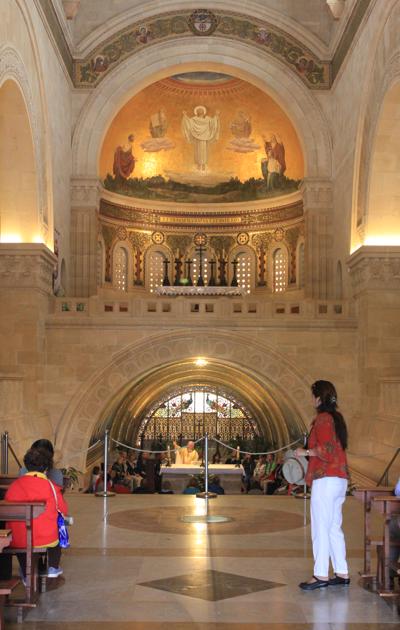
Philippi. They journeyed six days and then Jesus took Peter, James and John up a mountain. It is 80 miles from Caesarea Philippi to Mount Tabor which would be walked in six days. In the direction Jesus was going, Mount Tabor is the only mountain in the area so biblical scholars are reasonably confident that Mount Tabor is the place where Jesus was transfigured. Because the road to the top of the mount is narrow and twisty, we were dropped at a parking lot at the base of the mountain (in actuality, a high hill) and then got mini-buses to take us to the top.
There is a large compound at the top of the mountain which includes a church, a large monastery, ruins of prior structures built on the site, and extensive gardens. The church is very pretty. Although it looks older, it was built in the early 20th century and incorporates the remaining parts of the lower altar and apse from a 5th century
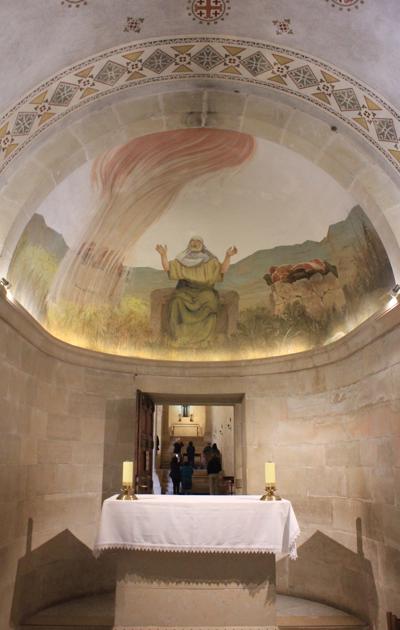

Byzantine church (see above for a view of the remains of the apse) . The altar is at the front of the church down about three or four steps from the main floor. Above this is what looks like a balcony which could have another altar although I don't know if that is the case. Above that is a mosaic of the Transfiguration showing Jesus flanked by Moses and Elijah with Peter, James and John nearby (picture on page 52). There are two small chapels at the front of the church dedicated to Moses and Elijah. The area above the altar in each chapel features a painting of the respective individuals (Moses on left and Elijah on right on page 53). We celebrated Mass in the lower altar area.
We moved on to Tabgha where we visited the Church of the Multiplication which commemorates Jesus's miracle of the multiplication of the loaves and fishes. The complex is run by

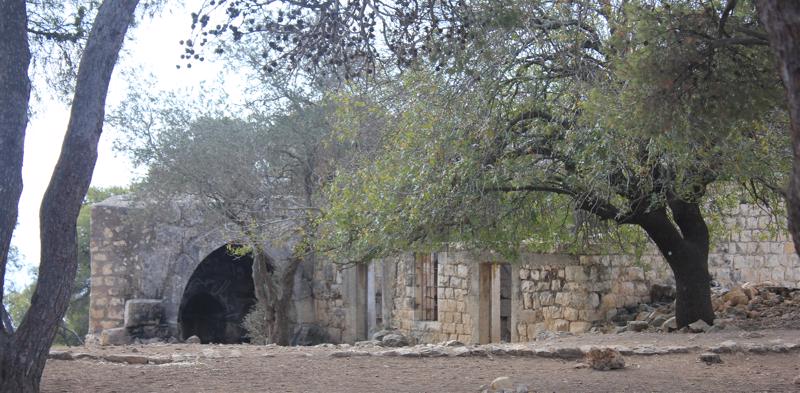
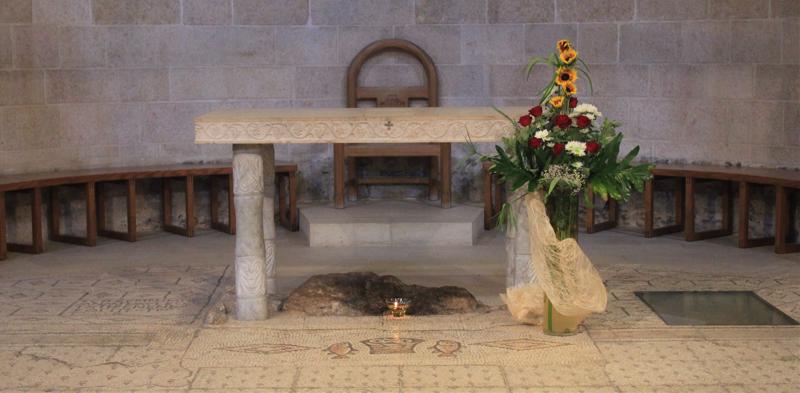

German Benedictines, one of the few Catholic shrines not managed by the Franciscans. There are ruins of former structures, the earliest dating from the mid-4th century (top picture on page 55). The modest church features an altar with an exposed rock underneath. Some Christian scholars believe that Jesus stood on this rock when He performed the miracle. In front of the altar is a mosaic that shows two fish and a basket with loaves of bread in it. I am not sure if the mosaic is supposed to date from the 4th century building. See the middle picture on page 55 for the altar and mosaic. The bottom picture shows the grounds of the complex.
Rami treated us to lunch at a local eatery. We all got pita bread with a spicy red concoction of hummus, I think, and a whole, broiled tilapia which was the most numerous fish in the Sea of Galilee in Christ's time. The tilapia was broiled with its head on and its skin slashed in

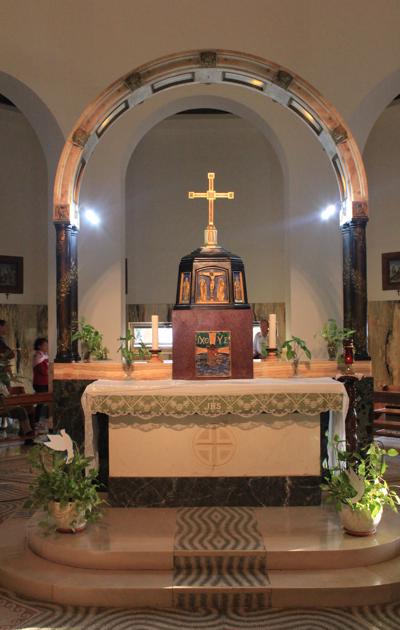
three or four places. The skin could be pulled off but not necessarily easily. Once you got to the meat, it was full of bones. Since I neither like to have my meal look at me nor like to work excessively to get my food, I ate little.
We went to the Mount of Beatitudes next where we found a small but beautiful octagonal chapel with each of the eight beatitudes written in Latin on stained glass panels set in each of the eight walls. A picture of the chapel is above, and pictures of the altar and one of the stained glass windows are on the next page.. There is a large monastery on the site that is run by Franciscan nuns. The grounds are well manicured, very pretty and extensive. One can get some nice views of the Sea of Galilee from the property.
We ended our day in Capernaum, home to Peter, Andrew, James and

John. The ruins of what is supposed to be Peter's house is under a large, modernistic structure with glass sides. The lower area is where the ruins can be seen although not clearly. For what it's worth, the inscription "Petros" is on one of the remaining walls in the same script as found on Peter's tomb under St. Peter's Basillica in the Vatican. The upper level has a modern chapel which looks as if it is regularly used for Catholic services. The ruins of a 2nd century synagogue along with the ruins of an earlier synagogue peaking through are a short distance from Peter's house. The later synagogue reflects a Greco-Roman architectural style and appeared to be fairly sizable (picture above).
We returned to our hotel about 5:00 and had dinner at 7:00. It is a nice hotel and has decent food.
Accommodations: Caesar Hotel
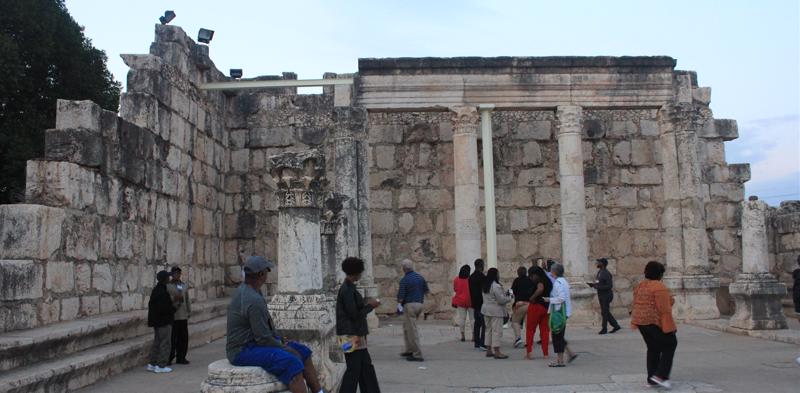
1.
Day One: Depart the USA
2.
Day Two: Arrive Tel Aviv & Bethlehem
3.
Day Three: Jerusalem
4.
Day Four: Places Near Bethlehem
5.
Day Five: Bethlehem
6.
Day Six: Jerusalem Again
7.
Day Seven: Jerusalem to Jordan & Petra
8.
Day Eight: Petra & Amman
9.
Day Nine: Amman to the Sea of Galilee
10.
Day Ten: Galilee
11.
Day Eleven: Tiberias to Tel Aviv
12.
Day Twelve: Return Home
13.
Post-Trip Reflections
Share your travel adventures like this!
Create your own travel blog in one step
Share with friends and family to follow your journey
Easy set up, no technical knowledge needed and unlimited storage!